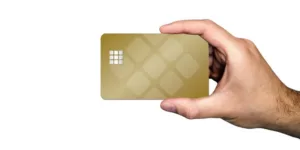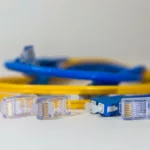Your card has a chip on it and now you insert instead of swipe. But why? How does the new chip card work and why is it better? Learn in this post.
Three years ago, chip cards hit the market and confused a lot of users. But now, they’re actually more popular than swipe cards, and many people find them easier to use.
However, when your bank sends you a new chip card, you might wonder why they sent it. What makes these cards better than swipe cards, and how do they work differently? Are they really any better at all?

In this guide, we’ll answer all your questions about chip cards. Keep reading to learn what that new chip card means for you!
What is an EMV Chip?
Sometimes, you might hear your chip card referred to as an “EMV card.”
EMV® is a registered word mark and not an abbreviation for Europay, Mastercard and Visa. Today, the technical body’s members comprise of American Express, Discover, JCB, Mastercard, UnionPay and Visa. To find out more visit: About EMVCo.
Today, chip cards are commonly referred to as EMV cards, even if they’re actually made by a company besides those big names. Many different types of cards now have a chip, from an MBNA Smart Cash card to a Chase Sapphire Reserve card.
You can tell the difference between a chip card and a swipe card right away. The new chip card will still have the same magnetic stripe where you’d expect to find it. However, it will also have a small visible chip on the front of the card.
How Your New Chip Card Works
The traditional magnetic stripe cards have the payment information encoded inside. That’s why a stolen credit card is such a big issue. Historically, it was easy for someone to steal a card, use it to make purchases, and then get rid of the card without getting caught.
And with the advent of e-commerce came the risk of card information getting stolen online, too. However, EMV cards have a way to reduce the risk of theft.
The chip on your new card is actually a real computer chip, that works as a very simple processor and transmitter. The information the magnetic strip on your old cards never changed — it just held the basic payment information. But the information on your chip card changes with every transaction. This actually uses the same technology used by cryptocurrencies.
When you make a payment with a chip card, you get a new transaction code each time. Of course, you don’t see or use the code. But this code means that someone stealing information from a single sale has nothing they can use. They don’t get access to static payment information, just a unique code that’s useless for future purchases.
This means that both online and in-person payments are more secure with a chip card. The same transaction code gets created for each online payment, making it much harder for a thief to get your payment information.
Why New Credit Cards With Chips are Popular
As you can imagine, this added security makes chip cards much more popular.
As e-commerce grew in popularity, so did the frequency of online credit card theft. As EMV cards become more popular, the rates of credit card fraud went down.
EMV cards are also easier to use in some ways. They can process a payment without an internet or phone connection. Stores outside of phone or internet range that used to have trouble taking credit payments can now take payment from an EMV card. The data from each card gets stored in the chip reader, and can be processed in a large batch at the end of the day as long as an internet connection is present.
Credit Card Chip FAQs
Curious about what using your new chip card on a daily basis will look like? These FAQs will clear up the most common questions you might have.
1. Is Fraud Still a Risk with an EMV Card?
Using your new chip card makes credit card fraud much less likely. However, it is still possible that someone will make a false purchase with a card that isn’t theirs.
However, most of the time, either the bank that issued the card or the payment processing company will be responsible for the losses, not you. And if someone steals a chip card and uses its swipe function because the store doesn’t yet have a chip reader, the merchant will be responsible for the loss.
This has helped pressure companies to adopt EMV technology to reduce the chances of fraud. While fraud is still possible with your new chip card, it’s less likely that you will have to pay for the fraudulent charges.
2. How Will I Use My New Chip Card?
With a chip card, paying is just as fast and easy, if not easier. Instead of having to swipe your card (and deal with the issues that happen when your card can’t be read), you simply insert the chip in the chip reader.
This is sometimes called “card dipping.” You “dip” the card into the chip reader and then wait while it processes. The chip reader verifies the card and creates the unique transaction code that helps protect from fraud.
This process will take a little bit longer than swiping. However, it’s both more secure and more simple. Just make sure not to take the card out of the reader before it’s ready, and you won’t have any issues.
3. Should I Travel With a Chip Card?
Many countries had already adopted EMV technology before the U.S. got on board. Traveling with your chip card is actually a great idea.
In fact, you’ll find that more merchants abroad can accept chip cards than swipe cards. That said, most countries accept chip cards with a PIN security feature. If yours involves a signature, you might find a few stores that can’t take your card. It’s always a good idea to take a backup card just in case — but it’s even better if both cards have a chip.
Ready to Use Your New Chip Card?
When you get a new chip card in the mail, it can seem like an annoyance at first. You have a new card number that you’ll need to set up with your online and auto pay accounts. However, the added security of a chip card makes these small inconveniences worth it.
Of course, having a chip card can still lead to racking up debts. Need help figuring out how to pay off your cards? Find out how to negotiate a repayment plan here.








